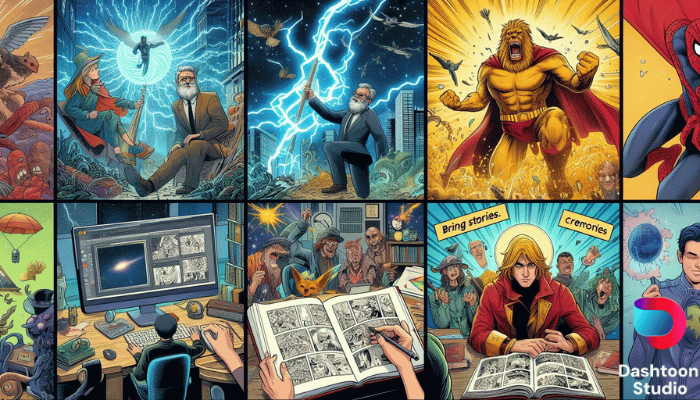How to Make a Comic Book: A Beginner’s Guide
Learn how to create your own comic book with this beginner's guide. Discover essential steps, from scripting to publishing, and unleash your creativity!

Creating a comic feels like piecing together a puzzle—you’re assembling your imagination panel by panel, shaping it into something that others can see and enjoy. The magic of a comic book lies in its ability to merge words and art, capturing stories in a way that no other medium can.
Whether you’re dreaming up your own superhero, crafting an epic fantasy world, or narrating a slice-of-life tale, making a comic is an exciting challenge. Let’s break down those pieces so that you know how to make a comic book without feeling overwhelmed.
Step-by-Step Guide on How to Make a Comic Book
Making your own comic book may seem like a massive undertaking, but when you break it down into simple, manageable steps, the process becomes much more approachable. Ready to unlock the power of your imagination and learn how to make a comic book? Here’s your roadmap.
Find Your Comic Idea
Every comic book begins with a killer idea. Before you worry about panels, artwork, or dialogue, you need a strong foundation—your concept. Think of your comic book as a visual novel, and your idea is the soul that drives it forward.
What kind of stories make your heart race? Are you into epic fantasy like Berserk or gritty realism like The Walking Dead? The beauty of comic book creation is that there are no rules for where your inspiration can come from. Jot down any wild idea that crosses your mind. Even if it seems absurd at first, it could be the start of something epic.
Ask yourself questions like: What kind of world are you building? Who are the characters living in it? What’s the conflict? Defining these will give your comic a purpose and direction.
Create a Script
Think of your comic script as the backbone—every great comic starts with a well-thought-out story. Now that you’ve locked in your idea, it’s time to flesh out the story in a way that makes sense visually. The script is where your comic book truly takes shape. It’s the blueprint that guides the entire process, so this step is crucial.
In your script, you’ll break down the plot into scenes and dialogue, panel by panel. Don’t worry—this doesn’t need to be overly detailed, but having a rough outline will help keep you on track. Think of the script as a way to capture pacing, dialogue, and important visual cues.
For example, when you write dialogue, focus on keeping it short and impactful. In comic books, less is often more because the visuals should tell the bulk of the story. Include stage directions like character emotions or background actions, which will give you an idea of how each scene should flow.
Here’s a simple structure to follow for your script:
- Panel 1: Describe what’s happening in the scene.
- Character 1 (dialogue): What’s the character saying or thinking?
- Character 2 (dialogue): How does the second character respond?
Once your script is ready, the next step is organizing it into visual panels.
Plan Your Panels and Layout
One of the coolest aspects of comic books is how the story is broken into panels, guiding the reader through the action in bite-sized chunks. Planning your comic book layout is all about balance—ensuring your artwork flows naturally while keeping the reader engaged.
Start by thinking about how you want to structure your pages. For example, Western comics are typically read from left to right, while manga is read from right to left. Consider how much space you want to dedicate to dialogue, action scenes, or establishing shots.
A good rule of thumb is to vary your panel sizes to keep things visually interesting. You could have a wide panel for an epic battle scene and smaller panels for quick dialogue exchanges.
You can experiment with layouts using simple sketches or templates to visualize how each page will flow. If you’re working on Dashtoon, you’ll find it easy to arrange your panels using our intuitive interface. This platform makes it easy to play around with layouts until you find what works best for your story.
Also Read: Comic Book Panels 101: Design Captivating Pages & Hook Readers
Develop Your Art Style
Now, let’s talk about the art itself—because even if you’ve got the best story in the world, the art is what will catch your reader’s attention first. But don’t worry if you’re not a professional artist! Developing a unique style is what makes your comic stand out.
Think of iconic comic styles, whether it’s the sharp lines of Attack on Titan or the whimsical characters in One Piece. What makes these comics memorable is the distinct look that matches the tone of the story. Whether your style leans toward realistic, cartoony, or somewhere in between, the key is consistency.
If you're not confident in your drawing skills, start simple. Rough sketches can evolve into more detailed work as you gain confidence. And remember, the story is just as important as the art—so don't let a lack of perfection stop you. Use references, study your favorite artists, and practice as much as you can.
Platforms like Dashtoon even allow artists to collaborate. You could team up with another creator to work on the visual side of your comic if you prefer to focus on writing!
Also Read: Exploring Different Comic Book Art Styles
Design Your Characters
Your characters are the stars of your comic. They drive the plot, build connections with readers, and give life to your story. Creating memorable characters is all about making them visually distinct and relatable.
When designing characters, think about their personality traits and how you can show them through their appearance. For example, does your protagonist wear practical armor because they’re constantly in battle, or do they have quirky accessories that reveal their personality?
You don’t need to overcomplicate this—just make sure the design feels right for the story. Sketch out different looks and styles until you land on one that feels like a perfect match. Whether you're going for the sleek, angular designs of modern manga or the gritty, rugged style of western comics, be sure to stick to your character's core attributes.
Keep in mind that your readers will often connect with characters through their visual appeal, especially in comics. A well-designed character can stay in the reader's mind long after they’ve finished your book.
If you want to create unique and memorable characters for your comic, check out Dashtoon's free AI character generator.
Also Read: From Sketch to Story: Comic Book Drawing Ideas and Tips
Finalize and Polish Your Comic
Now that you’ve written, sketched, and designed your comic book, it’s time for the finishing touches. This is where you’ll look over your work and ensure it’s polished and ready for your audience.
Go back through each panel, making sure the artwork is consistent and the dialogue flows naturally. This is also a great time to check the pacing. Do certain scenes drag on too long? Are there enough action beats to keep the reader engaged?
Proofreading is also essential—both for the script and the visual layout. Ensure the speech bubbles are clear and the text is easy to read. If you’re using digital tools like Dashtoon, you can even test different fonts to see which one matches your comic’s tone.
Once your comic book feels complete, gather feedback from friends or fellow creators. Sometimes an outside perspective can point out areas for improvement that you might not have noticed. Dashtoon has a supportive community where you can share your work in progress and get valuable insights.
Publish Your Comic
So, your comic book is ready. What now? Time to share it with the world! Fortunately, we live in a time where publishing your comic is easier than ever, thanks to digital platforms like Dashtoon.
With Dashtoon, you can upload your comic directly and reach a wide audience of readers who love discovering new creators. Our platform simplifies the publishing process, making it accessible for everyone, whether you’re a beginner or a seasoned pro. Plus, you can engage with fans, get feedback, and even monetize your work if that’s a goal.
Publishing your comic digitally also means you can update it, make revisions, and improve it over time—all while building a following.
Final Thoughts
Answering the question of how to make a comic book isn’t just about following steps—it’s about embracing the adventure of building something uniquely yours. As you craft your story, bring your characters to life, and sketch out each panel, you’re not just making a comic; you’re giving your imagination a place to thrive. Every piece of dialogue and every stroke of your pen gets you one step closer to making your vision a reality.
Now, it’s time to turn that vision into something tangible. So, grab your sketchpad, finalize that script, and start creating.
Ready to bring your comic to the world? Publish your story on Dashtoon and join a thriving community of creators, where your imagination can truly shine! With Dashtoon as your partner, you’ll have all the tools and support to bring your comic to life and share it with fans around the world.
FAQs
Q. Do I need to be a skilled artist to create a comic book?
A. Not necessarily! While strong art can enhance your comic, storytelling is just as important. If you’re not confident in your drawing skills, focus on developing a compelling script and collaborate with artists, or use digital tools like Dashtoon to bring your vision to life.
Q. How long should my first comic book be?
A. There’s no set rule! It can be as short as a few pages or as long as a full graphic novel. Many beginners start with short stories to get the hang of the process before tackling a longer project.
Q. What tools can I use to make a comic book?
A. You can start with simple tools like pencil and paper, or use digital software like Clip Studio Paint or Procreate. Platforms like Dashtoon provide more advances assistance like templates, panel layouts, and other features that simplify the comic-making process.
Q. What’s the best way to plan a comic book layout?
A. A good layout balances visual storytelling and pacing. Vary your panel sizes to keep readers engaged, and make sure each scene flows naturally. Sketch rough drafts of your pages first, and experiment with different formats until it feels right.
Q. How do I come up with a good idea for my comic?
A. Start by thinking about the kind of stories you enjoy, whether it’s superhero adventures, fantasy worlds, or slice-of-life moments. Jot down ideas, explore characters, and ask yourself what conflicts and themes you want to explore. Remember, there are no wrong ideas!
Q. Can I publish my comic digitally?
A. Yes! Publishing digitally is a great way to reach a wide audience. Dashtoon allows you to upload your comic, connect with readers, and even monetize your work. It’s an accessible option for both beginners and experienced creators.
Q. How do I get feedback on my comic before publishing?
A. You can share your comic drafts with friends, fellow creators, or online communities for feedback. Dashtoon offers forums and groups where creators can exchange ideas, get constructive criticism, and improve their work.
